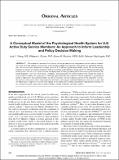| dc.description.abstract | The influence of individual-level factors such as pretraumatic risk and protective factors and the availability
of unit-level and enterprise-level factors on psychological health outcomes have been previously considered individually,
but have not been considered in tandem across the U.S. Military psychological health system. We use the existing
literature on military psychological health to build a conceptual system dynamics model of the U.S.Military psychological
health system “service-cycle” from accession and deployment to future psychological health screening and treatment. The
model highlights a few key observations, challenges, and opportunities for improvement for the system that relate to
several topics including the importance of modeling operational demand combined with the population’s psychological
health as opposed to only physical health; the role of resilience and post-traumatic growth on the mitigation of stress;
the positive and negative effects of pretraumatic risk factors, unit support, and unit leadership on the service-cycle; and
the opportunity to improve the system more rapidly by including more feedback mechanisms regarding the usefulness of
pre- and post-traumatic innovations to medical leaders, funding authorities, and policy makers. | en_US |
